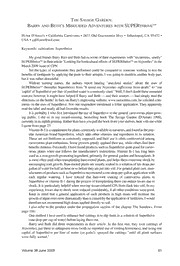Table Of ContentThe Savage Garden:
Barry and Beth’s Misguided Adventures with SUPERthrive™
Peter D'Amato • California Carnivores • 2833 Old Gravenstein Hwy • Sebastopol, CA 95472 •
USA
• [email protected]
Keywords: cultivation: Superthrive
MygoodfriendsBarryRiceandBethSalviawroteoftheirexperimentswith "mysterious, smelly"
SUPERthrive™intheirarticle "Lookingforhorticulturaleffects ofSUPERthrive™onNepenthes"inthe
March2009 issue ofCPN.
Yet the types ofexperiments they performed could be compared to someone wishing to test the
benefits oftoothpaste by applying the paste to theirarmpits. I was going to mention anotherbody pail,
butit wasratherdistasteful.
Without naming names, the authors report hearing "anecdotal stories" about the uses of
SUPERthrive™ (hereafter Superthrive) from "It saved my Nepenthes rafflesiana from death!" to "one
'capful' ofSuperthriveperliterofpurifiedwateris common—ly cited."Well, Idon'—tdoubtthese unnamed
sources; however, it might have helped ifBarry and Beth and their sources had simply readthe
directions on the bottle! Infact, on Bairy's engrossing website, www.saiTacenia.com, he solicitedcom-
ments on the uses ofSuperthrive. Not one respondent mentioned a foliar application. They apparently
readthelabel andnearly allhad favorableresults.
It is probably I who firstintroducedthe use ofSuperthrive to the general carnivorous plant-grow-
ing public. I did so in my award-winning, bestselling book The Savage Garden (D'Amato 1998),
currentlyinitseighthprinting.Ratherthanhaveyoupullthebookfromyourshelves,bearwithmewhile
Iquote frompage 23:
VitaminB-l isasupplementforplantscommonlyavailableinnurseries,andfoundinthepop-
ularAmerican brand Superthrive, which adds other vitamins and ingredients to its solution.
These are not fertilizers as commonly supposed, and then use is often controversial among
carnivorous plantenthusiasts. Some growers greatly applaudtheiruse, whileothers findthen
benefitsdubious. Personally,Ihavefoundproducts suchasSuperthrivequitegoodforcarniv-
orous plants when one follows the manufacturer's instructions. Vitamin B-l has long been
used as aroot-growth-promoting ingredient, primarily forgeneral garden andhouseplants. It
is mostoftenusedwhentransplantingbare-rootedplants, andhelps themovercome shockby
encouragingrootgrowth. Bare-rootedplants are usually soakedinasolutionoftendrops per
gallonofwaterforhalfanhourorsobeforetheyareputintosoil.Forgeneralplantcare,man-
ufacturersofproductssuchasSuperthriverecommendaone-drop-per-gallonapplicationwith
each regular watering. I have noticed that bare-root soaking of carnivorous plants in
Superthrive orvitaminB-l duringtheprocess oftransplantingthemcanreducelossesdueto
shock. It is particularly helpful when moving tissue-cultured CPs fromflaskinto soil. Inmy
experience, losses dueto shockwerereducedconsiderably, ifall otherconditions were good.
Keep in mind that a general application of such products in high doses will increase the
growthofalgaeevenmoredramaticallythaniscausedbytheapplicationoffertilizers.Iwould
thereforenotrecommendhighdoses applied directly to soil.
I also refer to the product under the propagation section of the chapter The Sundews. From
page 166:
One method I have used to enhance leafcuttings is to dip them in a solution ofSuperthrive
(one drop percup ofwater) before laying themout.
Barry and Beth did three experiments in their article. In the first one, they took cuttings of
Nepenthes putthemin sphagnummoss (withnoreporteduseofrootinghormones), andusing one
,
capful of Superthrive per liter of water (ye gods!), sprayed the cuttings "until all plant surfaces
were fully wetted."
Volume 38 June 2009 61
Inthe secondexperimentthey soakedfreshcuttings inadilutedconcentrationofSuperthrive.
Inthe thirdexperiment on established, rooted, pottedplants they again appliedafoliar spray once
aweekusingtwo drops pergallonofwater.
Well, considering what they did in then*experiments and then comparing it to whatthe manufac-
turer of Superthrive recommends in their directions, no wonder Barry and Beth concluded that they
"were unable to detectany beneficial effects from SUPERthrive™." Duhhhh!
Superthrive is not a fertilizer. It is not a rooting hormone. The primary ingredients (which the
authors never even mention in their article) are Vitamin B-l (.09%) and naphthylacetic acid (.048%).
Vitamin B-l (VB1) is thiamine hydrochloride, which is normally produced in the leaves ofplants and
then sent down to the roots and promotes root growth. Naphthylacetic acid is a hormone known to
enhancerootgrowthandisoftenfoundinvariousfertilizers. Thehyperboleof"50vitamins-hormones"
found in Superthrive's advertising I don't doubt since the company used to produce liquid human vita-
mins untilpillsbecame all therage. Butthe above-mentionedingredients are the only two actually list-
ed onthe label.
I have found that using the product the way Irecommend in The Savage Garden yields the same
resultsasusinghorticulturalVB1 inreducingtransplantshockofROOTEDplantsandingreatlyincreas-
ingplantletgrowthofsundewleafcuttings,orforthatmatter,flytrapandbutterwortleafcuttingsaswell.
I didthesepersonal, undocumentedexperiments inthe 1980s.
OnethingBarryandBethdidn'tmentionisthatiftheyreallysprayedthecuttingswiththeextreme-
ly high dosage ofSuperthrive reported in the experiments, they must have soon seen an abundance of
"green." That would have been from algae and slime mold which would have rapidly grown on the
sphagnummossestheircuttings wererootedin.
Here's an experiment for you: In a gallon ofpurified water, add about ateaspoon ofalgae-ridden
water and ateaspoon ofSuperthrive orVB1. As acontrol, do the same with a second gallon, omitting
the Superthrive orVB1. Place both gallons in the sun for several days and let me know what happens.
Think St. Patrick's Day.
Here's anotherexperiment. Take two fresh, healthy sundew leaves, dipping one into a cup of
water containing one to three drops of Superthrive or VB1. Do nothing to the second leaf. Lay
both leaves out on milled sphagnum or peat moss as you would for typical leaf-cutting propaga-
tion. Let us know what happens.
I have used and sold Superthrive at my nursery California Carnivores for twenty years. I almost
neveruseitmixedwithfertilizers (one drop pergallon) as themanufacturerrecommends, althoughthis
might enhance aplant's absorption ofminerals. W—e mostly foliarly feed our CP anyway, so not getting
into theroots, the Superthrive woulddo nothing as Barry andBeth amplyproved!
Incidentally, theVitaminInstitute, whichmanufactures Superthrive, has offereda$5,000 awardto
anyone who can disprove their suggested beneficial uses of "the stuff," as they call it. It has remained
unclaimedfor69 years! Iguess those whodidtry to getthe awardbecame....converted! Invasion ofthe
Body Snatchers! How do you think they propagated so many ofthose Pods?And the duplicates who
emergedfrom thePods were all wearing SuperthriveT-shirts! (Offeredfree toretailers of"the stuff.")
Seriously, the seemingly outrageous claims on Superthrive's packaging and website
(www.superthiive.com) do seemabitoverthe top. However, it was this sort ofadvertising that wonits
inventor, John A. Thompson, a lifetime achievement award in marketing. It has generally eliminated
from nursery shelves mostVB1 competition. I met the elderly Mr. Thompson at a horticultural trade
show someyears back, andhe is quite acharacter! Notunlike the labels ofhis bottles!
Barry and Beth should have concluded their article by claiming their foliar application of
Superthrive, which showed no beneficial results, was only Phase One. More experiments are needed.
Stay tuned!
References
D’Amato, P. 1998. The Savage Garden. Ten SpeedPress, Berkeley, California. 314 p.
Rice, B.A., and Salvia, E.M. 2009. Looking for horticultural effects of SUPERthrive™
onNepenthes. Carniv. PI. Newslett. 38: 24-27.
62 Carnivorous Plant Newsletter

